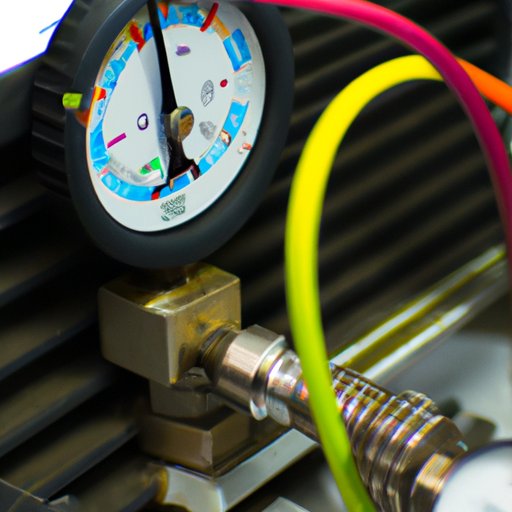Introduction
A strain gauge is a device used to measure force and strain on an object. It is typically used in engineering and manufacturing applications, such as monitoring the performance of bridges or aircraft components, or measuring the amount of pressure applied to a material during a manufacturing process. It is also used in medical applications, such as measuring body movement or muscle tension.

Exploring the Mechanics Behind How a Strain Gauge Works
In order to understand how a strain gauge works, it is important to first understand the basic components that make up the device. A strain gauge consists of two main parts: a sensing element and a Wheatstone bridge circuit. The sensing element is the part of the device that actually measures the force or strain being applied. It is typically made of a thin metal wire or foil that is attached to the object being measured. When the object is subjected to a force or strain, the sensing element will stretch or compress, causing its electrical resistance to change.
The Wheatstone bridge circuit is used to measure the change in electrical resistance of the sensing element. It consists of four resistors arranged in a diamond-shaped configuration. When a voltage is applied to the bridge, the current flowing through each resistor is measured. By comparing the current flowing through each resistor, it is possible to calculate the electrical resistance of the sensing element and thus determine the amount of force or strain being applied to the object.
Comprehensive Guide to Understanding Strain Gauge Operation
There are several different types of strain gauges, each with its own unique set of characteristics and uses. Resistance strain gauges are the most commonly used, and they work by measuring changes in electrical resistance. These are ideal for measuring small forces and strains, such as those found in medical applications. For larger forces and strains, such as those found in industrial applications, displacement strain gauges are often used. These measure changes in displacement rather than electrical resistance.
Regardless of the type of strain gauge used, there are several benefits to utilizing them in engineering and manufacturing. They are highly accurate and reliable, and can be used to measure even the smallest forces and strains. Additionally, they are relatively inexpensive, making them cost effective for many applications. And because they are non-intrusive, they can be used to measure forces and strains without disrupting the operation of the object being measured.

Investigating the Calibration and Installation Process for Strain Gauges
Once you have chosen the right strain gauge for your application, the next step is to properly install and calibrate it. To do this, you will need a few pieces of equipment, such as a strain gauge amplifier, a multimeter, and a load cell. The strain gauge amplifier is necessary to amplify the small signals produced by the strain gauge, while the multimeter is used to measure the electrical resistance of the strain gauge. The load cell is used to apply a known force or strain to the object being measured, which can then be compared to the output of the strain gauge amplifier to ensure accuracy.
When installing the strain gauge, it is important to take certain precautions to ensure accuracy. The strain gauge should be mounted securely to the object being measured, and the surface should be clean and free from any debris or contaminants. Additionally, the wires connecting the strain gauge to the amplifier should be insulated to prevent interference. Finally, the strain gauge should be calibrated regularly to ensure accuracy over time.
Conclusion
Strain gauges are essential devices for measuring force and strain in engineering and manufacturing applications. They are highly accurate and reliable, and can be used to measure even the smallest forces and strains. To ensure accuracy, it is important to properly install and calibrate the strain gauge, and to use the right type of strain gauge for the application. With the right strain gauge, engineers and manufacturers can gain valuable insight into the performance of their products and processes.
When choosing a strain gauge, it is important to consider the needs of the application and select a strain gauge that meets those needs. It is also important to consider the installation and calibration process, and to choose a strain gauge that is easy to install and calibrate. With the right strain gauge and proper installation and calibration, engineers and manufacturers can trust that their data is accurate and reliable.
(Note: Is this article not meeting your expectations? Do you have knowledge or insights to share? Unlock new opportunities and expand your reach by joining our authors team. Click Registration to join us and share your expertise with our readers.)
